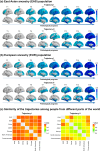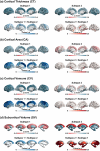Neurostructural subgroup in 4291 individuals with schizophrenia identified using the subtype and stage inference algorithm
- PMID: 39013848
- PMCID: PMC11252381
- DOI: 10.1038/s41467-024-50267-3
Neurostructural subgroup in 4291 individuals with schizophrenia identified using the subtype and stage inference algorithm
Abstract
Machine learning can be used to define subtypes of psychiatric conditions based on shared biological foundations of mental disorders. Here we analyzed cross-sectional brain images from 4,222 individuals with schizophrenia and 7038 healthy subjects pooled across 41 international cohorts from the ENIGMA, non-ENIGMA cohorts and public datasets. Using the Subtype and Stage Inference (SuStaIn) algorithm, we identify two distinct neurostructural subgroups by mapping the spatial and temporal 'trajectory' of gray matter change in schizophrenia. Subgroup 1 was characterized by an early cortical-predominant loss with enlarged striatum, whereas subgroup 2 displayed an early subcortical-predominant loss in the hippocampus, striatum and other subcortical regions. We confirmed the reproducibility of the two neurostructural subtypes across various sample sites, including Europe, North America and East Asia. This imaging-based taxonomy holds the potential to identify individuals with shared neurobiological attributes, thereby suggesting the viability of redefining existing disorder constructs based on biological factors.
© 2024. The Author(s).
Conflict of interest statement
LP reports personal fees from Janssen Canada, Otsuka Canada, SPMM Course Limited UK and the Canadian Psychiatric Association; book royalties from Oxford University Press; and investigator-initiated educational grants from Sunovion, Janssen Canada and Otsuka Canada, outside the submitted work. TK received unrestricted educational grants from Servier, Janssen, Recordati, Aristo, Otsuka, neuraxpharm. PH has received grants and honoraria from Novartis, Lundbeck, Mepha, Janssen, Boehringer Ingelheim, Neurolite outside of this work. OAA is a consultant to Cortechs.ai and received speakers honorarium from Lundbeck, Janssen, Sunovion. Other authors disclose no conflict of interest.
Figures




References
-
- Organization W. H. The Global Burden Of Disease: 2004 Update. (World Health Organization, 2008).
MeSH terms
Grants and funding
LinkOut - more resources
Full Text Sources
Medical
Miscellaneous

